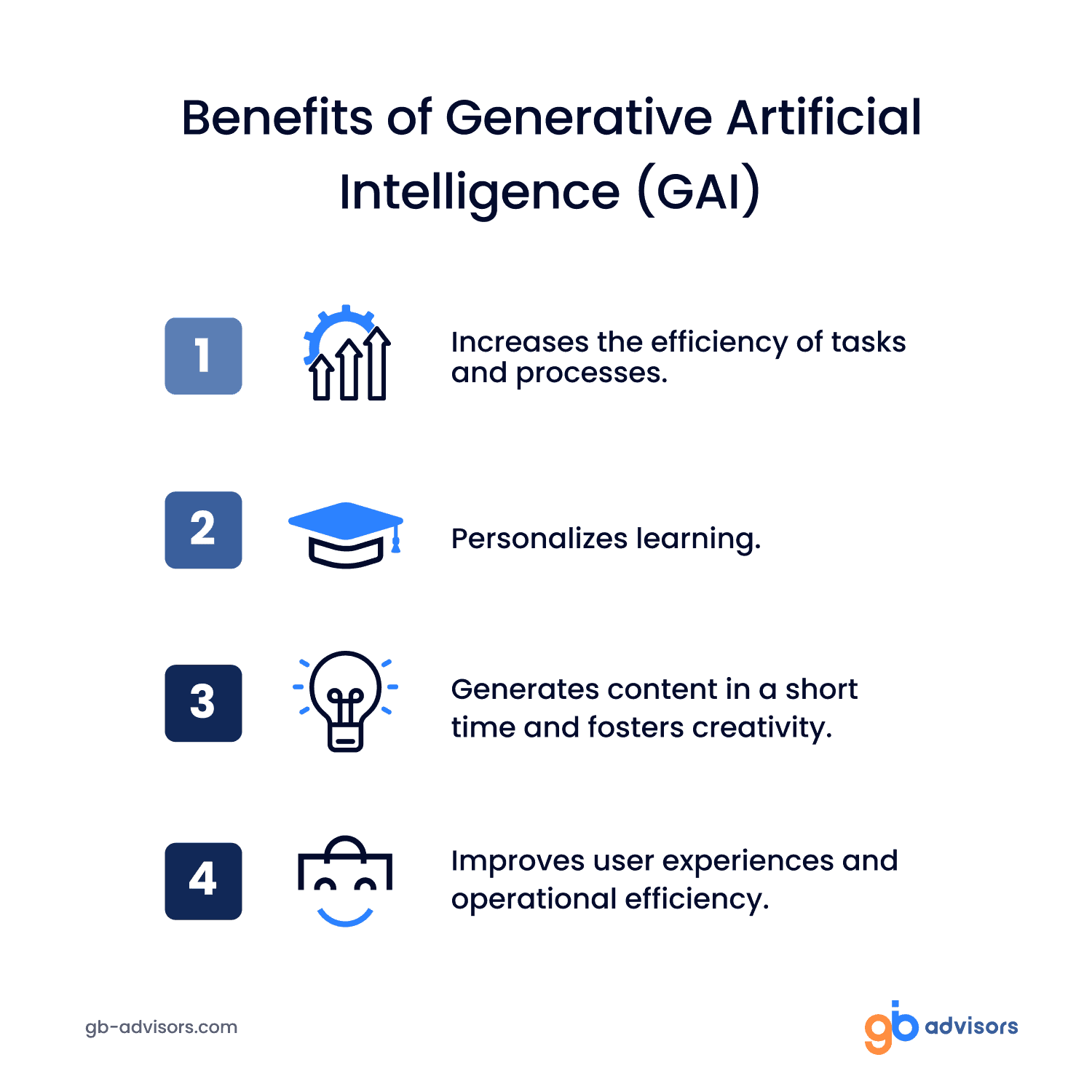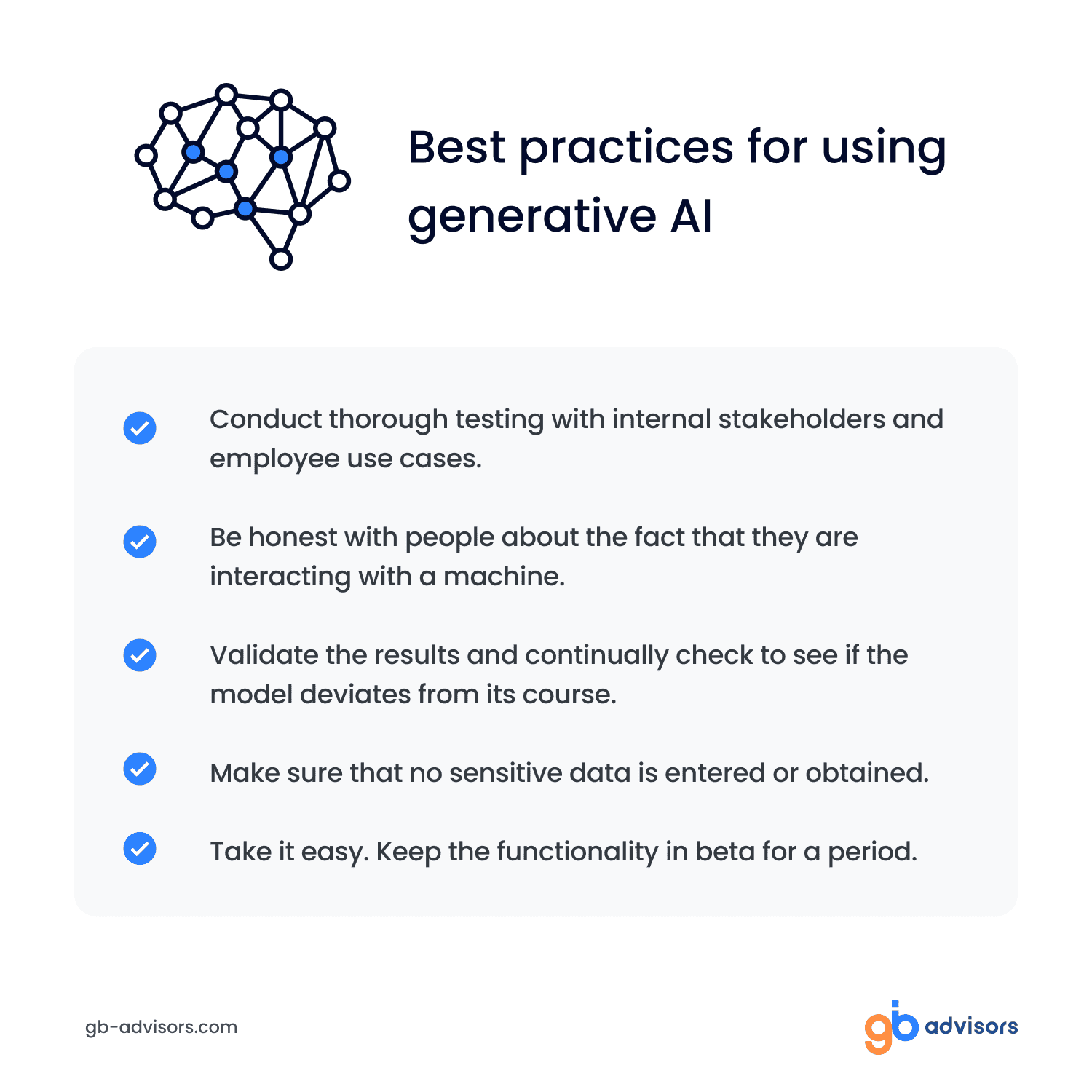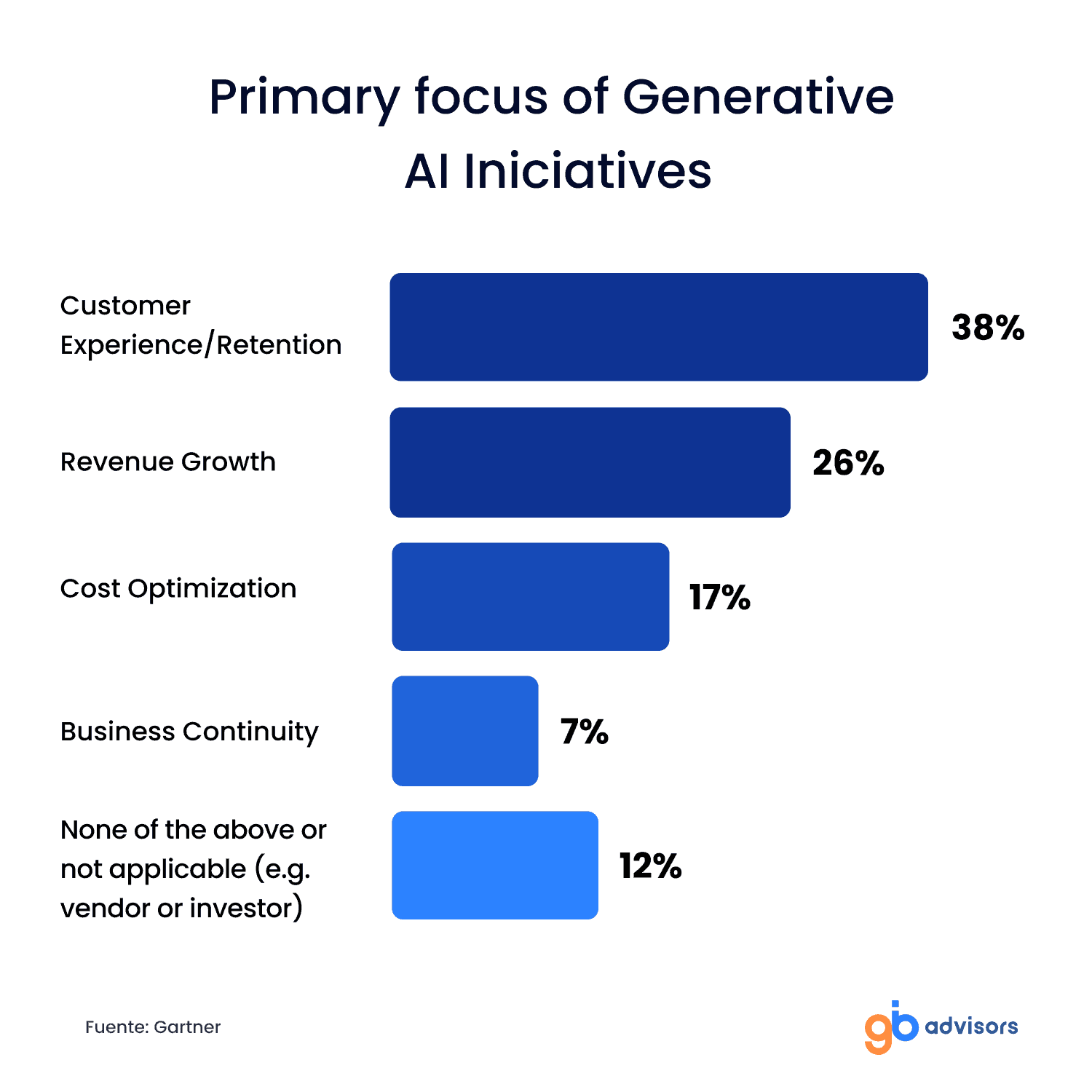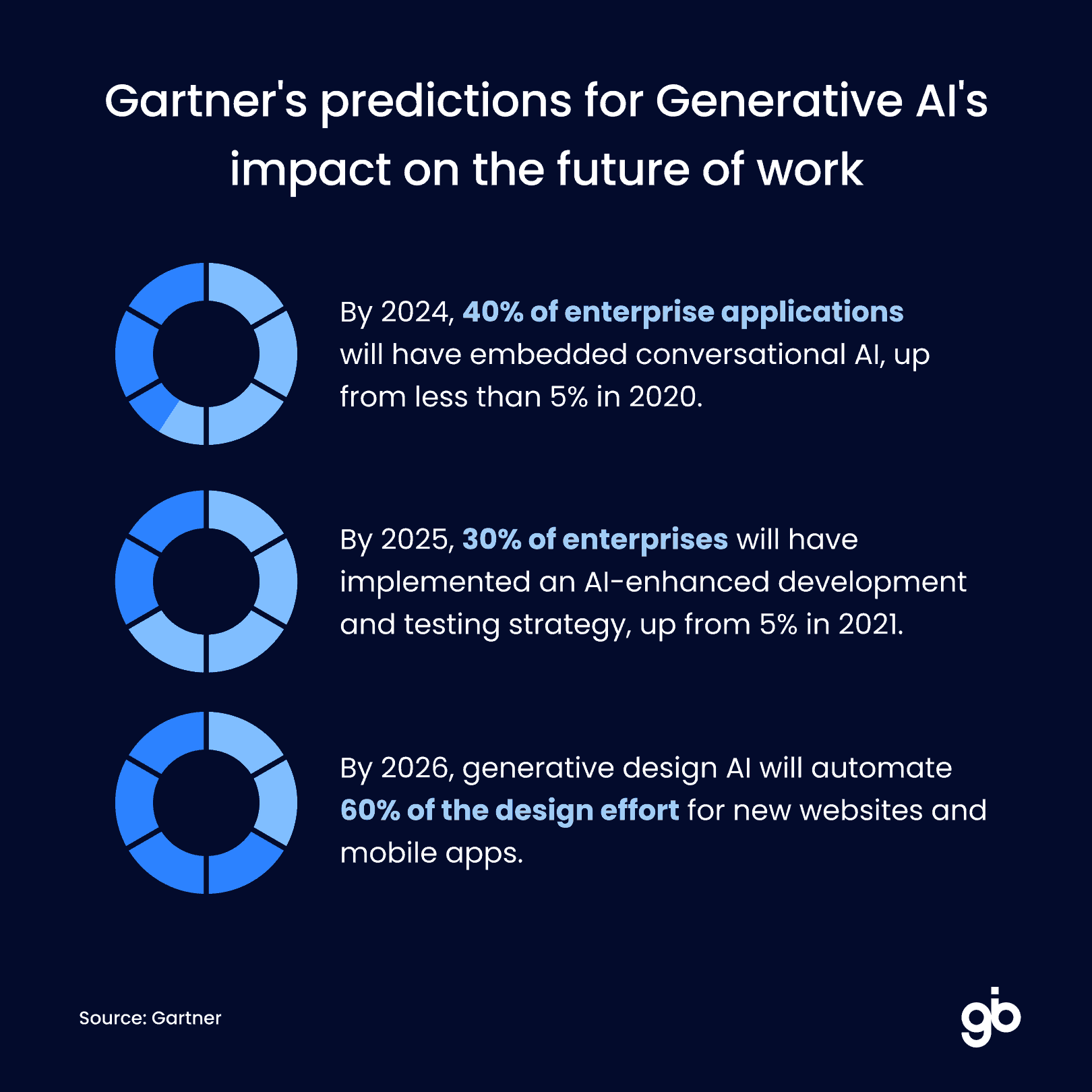Generative artificial intelligence (GAI), or Generative AI, is no longer a futuristic concept but a reality. But, have you heard of it? You probably use or have used tools such as ChatGPT, for example.
GenAI is a specialized branch that goes beyond data analysis and processing. Its ability to generate original and innovative content distinguishes it from other forms of AI. How does it achieve this? What are its applications? What is its future? What impact is it having on the way we work and do business? These are some questions we will seek to answer today. If you are interested, be sure to read 😊.
Introduction to Generative Artificial Intelligence
Generative AI is artificial intelligence that uses machine learning models to generate content. This includes text, images, videos, and music, among others.
Generative AI models, instead of simply processing and analyzing data, generate new data from existing data. In other words, they learn from patterns and structures to produce novel results. Their operation is based on deep neural networks. These are computer systems that emulate the functioning of the human brain. And they learn and adapt as they process more information.
For example, a generative AI can be trained on thousands of famous paintings. It will learn the styles and techniques used in those paintings, and then generate its own original painting similarly.

Exploring the Basics of Generative AI
GenAI uses a variety of techniques and technologies to produce its results. Two of the most common approaches are:
- Generative Adversarial Networks (GANs).
- Variational Autoencoders (VAE).
Both methods employ deep neural networks but in very different ways. Let’s see!
Generative Adversarial Networks (GANs)
GANs are a type of neural network used to generate data that did not previously exist. They were introduced by Ian Goodfellow and colleagues in 2014. GANs consist of two parts: a generator and a discriminator.
- The generator creates new data from random noise.
- The discriminator attempts to distinguish between real and generated data.
These two components work together in a feedback loop. The generator tries to produce data that the discriminator cannot differentiate from the real data, and the discriminator strives to improve its ability to detect falsified data.
To understand this better, let’s follow a simple example. Imagine that GANs are like an artist and an art critic working together. Imagine that the artist (the generator) is trying to make a painting so good that the critic (the discriminator) cannot tell if it is a real work of art or a fake.
The “artist” starts with a blank canvas (random noise) and creates something new. Then, the “critic” looks at this new artwork and compares it to real artwork to see if he can tell the difference. If the “critic” detects that it is a fake, he gives feedback to the “artist” so that he can improve his work.
A real example of this is how GANs are used to generate realistic images of people who do not exist. If you’ve ever seen one of those “people who don’t exist” images online, that’s the work of a GAN.
Variational Autoencoders (VAEs)
VAEs are another type of neural network used in IAG. Unlike GANs, which generate data from random noise, VAEs use an existing input to produce a new output.
A VAE consists of two parts: an encoder and a decoder. The encoder takes the input data and compresses it into a latent representation, a sort of “summary” of the data. Then, the decoder takes this representation and reconstructs it into a new output.
To understand this better, let’s take the example of the artist and his work. VAEs are like an artist recreating his favorite work of art, but with his own unique style. First, the “artist” (the encoder) studies the original work and creates a “summary” of what makes that work special. This “summary” is what we call a latent representation.
Then, the “artist” takes that “summary” and uses it to create a new work of art (the decoder). But here’s the interesting part: instead of making just one version of the original work, the “artist” can make many versions, all based on the same “abstract”.
An example of this might be a VAE that takes an image of a cat and generates several images of cats. All the images are recognizably of cats, but each has its own unique style or look. Another application could be in text translation, where a VAE could take an English sentence and generate multiple valid translations in another language.
Both techniques, GANs, and VAEs, are fundamental to the advancement of Generative AI and continue to be active areas of research and development.
Pioneering Applications of Generative AI
As we have already mentioned, Generative AI has had a number of pioneering applications in art and design, text generation, and speech synthesis. Let’s see a little more about this:
In Art and Design
GenAI has revolutionized the world of art and design. For example, it is being used to build metaverses, creating unique codes and designs that were previously difficult or impossible to achieve. In addition, graphic design tools such as Piktochart, Affinity Designer, Sketch and InVision Studio have integrated AI into their processes.
In Text Generation
Products like ChatGPT have changed the way we generate and use text. These tools can generate text autonomously. And this is very useful for a variety of tasks: from writing reports to creating content for blogs or social networks.
In Voice Synthesis
IAG applications produce synthesized human speech that is almost indistinguishable from the real human voice. This has important implications in the field of virtual assistants or audiobook narration.
Overall, generative AI is proving to be a versatile and powerful tool, with applications in a wide range of industries and disciplines.

The Impact of Generative AI on Business
In the business world, Generative AI is driving and changing the way business processes are carried out. This includes everything from process automation to generating innovative solutions to complex challenges. According to a McKinsey report, GenAI has ample potential to generate significant value in a variety of industries.
Streamlining Sales Processes
IAG can automate and streamline the sales process. For example, it can automatically send emails based on customer behavior, enabling more personalized and effective communication.
Increased Productivity
When combined with automation and real-time data analytics, Generative AI can improve employee experience and productivity. This is because it takes over routine and repetitive tasks, freeing employees to focus on more strategic and creative tasks.
Redesigning Business Strategies
GenAI is positively impacting the design of business strategies. By being able to generate new ideas and content, it helps companies innovate and adapt more quickly to market changes.
Error Reduction
Generative AI reduces human errors and increases process accuracy. This ensures greater efficiency and cost savings.

Innovations and Future Trends in Generative AI
Generative AI is constantly evolving. Therefore, future innovations and trends in this area promise to be exciting.
First, it is expected that GenAI will enable greater personalization in a variety of applications. From product recommendations to adaptive user experiences, especially in the post-purchase stage.
In addition, content generation with IAG is a field that is continuously improving. So expect faster and more efficient content generation and in the audiovisual area much more realistic.
And, above all, IAG has great potential in the field of virtual and augmented reality. It is already being used to generate realistic and adaptive virtual environments. This can have applications in a variety of fields, not only in video games, but even in virtual training and education.
As for the use of AGI in industries and its impact on the future of work, we have some important predictions from Gartner for the next three years:

Conclusion
In short, Generative AI is an indispensable tool today for many industries. This technology is increasingly being incorporated into business management software tools.
With its ability to generate creative and highly personalized content, it has revolutionized the way companies interact with their customers, delivering unique experiences and improving operational efficiency.
As we continue to move towards a more digital future, the role of Generative AI will only become more critical. However, we must also be aware of the ethical and security challenges posed by this technology and work to mitigate them.
Need advice on the best management and automation platforms for companies that are applying Generative AI? Contact us we’re here to help you 😊.



